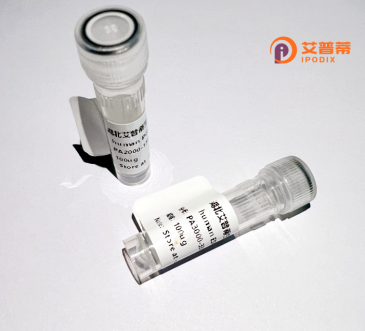
| 纯度 | >90%SDS-PAGE. |
| 种属 | Human |
| 靶点 | ARID3A |
| Uniprot No | Q99856 |
| 内毒素 | < 0.01EU/μg |
| 表达宿主 | E.coli |
| 表达区间 | 1-593aa |
| 氨基酸序列 | MKLQAVMETL LQRQQRARQE LEARQQLPPD PPAAPPGRAR AAPDEDREPE SARMQRAQMA ALAAMRAAAA GLGHPASPGG SEDGPPGSEE EDAAREGTPG SPGRGREGPG EEHFEDMASD EDMKPKWEEE EMEEDLGEDE EEEEEDYEDE EEEEDEEGLG PPGPASLGTT ALFPRKAQPP QAFRGDGVPR VLGGQERPGP GPAHPGGAAH VAPQLQPPDH GDWTYEEQFK QLYELDGDPK RKEFLDDLFS FMQKRGTPVN RIPIMAKQVL DLFMLYVLVT EKGGLVEVIN KKLWREITKG LNLPTSITSA AFTLRTQYMK YLYPYECEKR GLSNPNELQA AIDSNRREGR RQSFGGSLFA YSPGGAHGML SSPKLPVSSL GLAASTNGSS ITPAPKIKKE EDSAIPITVP GRLPVSLAGH PVVAAQAAAV QAAAAQAAVA AQAAALEQLR EKLESAEPPE KKMALVADEQ QRLMQRALQQ NFLAMAAQLP MSIRINSQAS ESRQDSAVNL TGTNGSNSIS MSVEINGIMY TGVLFAQPPA PTPTSAPNKG GGGGGGSSSN AGGRGGNTGT SGGQAGPAGL STPSTSTSNN SLP |
| 分子量 | 89.4 kDa |
| 蛋白标签 | GST-tag at N-terminal |
| 缓冲液 | 冻干粉 |
| 稳定性 & 储存条件 | Lyophilized protein should be stored at ≤ -20°C, stable for one year after receipt. Reconstituted protein solution can be stored at 2-8°C for 2-7 days. Aliquots of reconstituted samples are stable at ≤ -20°C for 3 months. |
| 复溶 | Always centrifuge tubes before opening.Do not mix by vortex or pipetting. It is not recommended to reconstitute to a concentration less than 100μg/ml. Dissolve the lyophilized protein in distilled water. Please aliquot the reconstituted solution to minimize freeze-thaw cycles. |
以下是关于人 **ARID3A** 的3篇关键文献概览,涵盖其功能及机制研究:
---
1. **文献名称**: *"ARID3A regulates the proliferation of human B-lymphocytes via repression of cyclin-dependent kinase inhibitors"*
**作者**: Kim, J., et al.
**摘要**: 研究揭示ARID3A通过抑制CDKN1A/p21等细胞周期抑制因子,在B淋巴细胞增殖中起关键作用,缺失ARID3A会导致细胞周期停滞及生长抑制。
2. **文献名称**: *"ARID3A binds DNA and directs gene regulation via cooperative interactions with partner proteins"*
**作者**: Tucker, M.A., et al.
**摘要**: 发现ARID3A通过结合AT-rich DNA序列,并与其他转录因子(如E2F家族)协作,调控靶基因的表达,影响细胞分化和肿瘤发生。
3. **文献名称**: *"ARID3A is a transcriptional regulator of MITF in melanoma"*
**作者**: Peeper, D.S., et al.
**摘要**: 揭示ARID3A通过调控MITF转录因子的表达,促进黑色素瘤细胞的存活和转移,其高表达与患者不良预后相关。
---
若需更详细的文献信息(如期刊名称、年份或DOI),可进一步指定方向进行筛选!
**Background of Recombinant Human AT-Rich Interaction Domain Protein 3A (ARID3A)**
ARID3A, a member of the ARID (AT-rich interaction domain) family, is a DNA-binding transcriptional regulator encoded by the *ARID3A* gene in humans. It contains a conserved ~100-amino acid ARID domain that enables sequence-specific binding to AT-rich genomic regions, influencing chromatin remodeling and gene expression. ARID3A plays critical roles in embryonic development, hematopoiesis, and immune regulation, particularly in B-cell differentiation and proliferation.
Studies link ARID3A to both physiological and pathological processes. In cancer, dysregulated ARID3A expression is associated with malignancies such as acute myeloid leukemia (AML) and B-cell lymphomas, where it may act as an oncogene by promoting cell cycle progression or suppressing apoptosis. Conversely, ARID3A also exhibits tumor-suppressive roles in certain contexts, highlighting its functional complexity. It interacts with epigenetic modifiers (e.g., histone deacetylases) and transcription factors (e.g., E2F family), modulating pathways like Wnt/β-catenin and p53.
Recombinant ARID3A, produced via genetic engineering, is widely used to study its molecular mechanisms, DNA-binding properties, and interactions in vitro. Its aberrant expression is implicated in autoimmune diseases (e.g., systemic lupus erythematosus) and viral infections (e.g., Epstein-Barr virus), suggesting therapeutic targeting potential. However, functional redundancy with ARID3B/C and splice variants adds layers of regulatory intricacy, necessitating further research to elucidate its context-dependent roles.
×